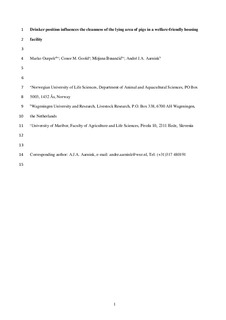| dc.contributor.author | Ocepek, Marko | |
| dc.contributor.author | Goold, Conor Michael | |
| dc.contributor.author | Busancic, Mirjana | |
| dc.contributor.author | Aarnink, Andre JA | |
| dc.date.accessioned | 2017-12-11T12:35:25Z | |
| dc.date.available | 2017-12-11T12:35:25Z | |
| dc.date.created | 2017-09-29T10:46:07Z | |
| dc.date.issued | 2017 | |
| dc.identifier.issn | 0168-1591 | |
| dc.identifier.uri | http://hdl.handle.net/11250/2470215 | |
| dc.description.abstract | Understanding eliminative behaviour in pigs is a priority for designing pig facilities. Pigs prefer to lie in areas separated from where they eliminate (urinate, defecate). Welfare-friendly housing facilities include separate areas for lying (solid floors) and elimination (slatted floors). To prevent pen fouling, ways to reduce the amount of eliminative behaviour on the solid floor area are essential. This study investigated whether the position of the drinkers influences areas preferred for eliminative behaviour in growing-finishing pigs (n = 432; over two batches) assigned to one of three drinker treatments: two drinkers placed in the inner slatted area (IN group; n = 8 pens), two drinkers in the outer slatted area (OUT group; n = 8 pens), or a drinker in each of the inner and outer slatted areas (IN_OUT group; n = 8 pens). We predicted that the OUT group would have fewer elimination events on the inner solid area than the IN group. The number of eliminations in the IN_OUT group was predicted to be a compromise between the IN and OUT group patterns. In addition, we quantified the diurnal variation of lying and eliminative behaviour in different pen areas with respect to temperature, and the effect of pigs lying in eliminatory areas on eliminative behaviour. On the solid floor area, the OUT group urinated 32.5% less frequently and defecated 30.4% less frequently than the IN group. For urination preferences, the IN_OUT group was intermediate between IN and OUT groups on the inner solid floor, but not for defecation. No significant differences in lying preferences were found between drinker groups on the inner solid area. Elimination (urination and defecation) was most prevalent in the afternoon (15:00 and 14:00 h, respectively) and least prevalent during the night (03:00 and 00:02 h, respectively). A one SD increase in temperature (approximately 6°C) was associated with a 42.3% decrease in lying observations on the inner solid area, while the percentage of elimination on the solid floor increased (urination: 75.8%; defecation: 139.5%). Our results showed that the placement of drinkers in the outer area compared to the inner area resulted in less pen fouling (fewer eliminations on the solid floor) and, thus, provided pigs with a cleaner solid area for lying. This study has identified a simple method of increasing the cleanliness of pigs’ dedicated lying areas, which has important implications for improving the design of pig housing facilities and maximising pig welfare. | nb_NO |
| dc.language.iso | eng | nb_NO |
| dc.rights | Attribution-NonCommercial-NoDerivatives 4.0 Internasjonal | * |
| dc.rights.uri | http://creativecommons.org/licenses/by-nc-nd/4.0/deed.no | * |
| dc.title | Drinker position influences the cleanness of the lying area of pigs in a welfare-friendly housing facility | nb_NO |
| dc.type | Journal article | nb_NO |
| dc.type | Peer reviewed | nb_NO |
| dc.description.version | acceptedVersion | nb_NO |
| dc.source.journal | Applied Animal Behaviour Science | nb_NO |
| dc.identifier.doi | 10.1016/j.applanim.2017.09.015 | |
| dc.identifier.cristin | 1500251 | |
| dc.relation.project | Andre: Ministry of Economic Affairs of the Netherlands, Host, Kempf | nb_NO |
| cristin.unitcode | 192,10,1,0 | |
| cristin.unitname | Institutt for husdyr- og akvakulturvitenskap | |
| cristin.ispublished | false | |
| cristin.fulltext | postprint | |
| cristin.qualitycode | 1 | |

